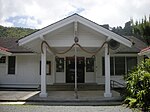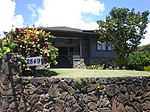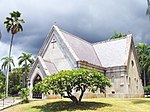Hānaiakamalama
Historic American Buildings Survey in HawaiiHistoric house museums in HawaiiHouses in Honolulu County, HawaiiHouses on the National Register of Historic Places in HawaiiMuseums in Honolulu ... and 2 more
National Register of Historic Places in HonoluluRoyal residences in Hawaii

Hānaiakamalama or Queen Emma Summer Palace, served as a retreat for Queen Emma of Hawaii from 1857 to 1885, as well as for her husband King Kamehameha IV, and their son, Prince Albert Edward. It is a now a historic landmark, museum, and tourist site located at 2913 Pali Highway, less than a ten-minute drive outside of downtown Honolulu, Hawaii. The museum is open daily from 9:00 a.m. to 4:00 p.m., and is maintained with entrance fees, revenue from the gift shop, and other funds raised by the Daughters of Hawaii.
Excerpt from the Wikipedia article Hānaiakamalama (License: CC BY-SA 3.0, Authors, Images).Hānaiakamalama
Puiwa Road, Honolulu Nuuanu
Geographical coordinates (GPS) Address Nearby Places Show on map
Geographical coordinates (GPS)
| Latitude | Longitude |
|---|---|
| N 21.335555555556 ° | E -157.83888888889 ° |
Address
Nuuanu Valley Park Playground
Puiwa Road
98622 Honolulu, Nuuanu
Hawaii, United States
Open on Google Maps










